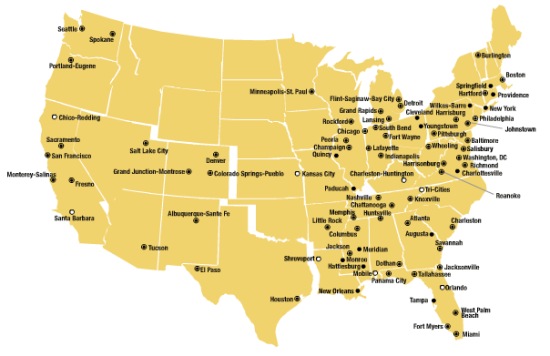Recently, a number of cable companies have been dropping hints about offering cellphone / wireless Internet service. So far they’ve just been baby steps, with a small test rollout here, or a limited test deployment there. But thus far, none of the CableCos really have much to show for all their talk.
But the cable companies need to think bigger, much bigger: If they do, both you and they will end up winners. Here’s why:
- The Story Thus Far
As mentioned, a few cable companies have already stuck their little toes into the cellphone market waters. To date, Cox, the nation’s third-largest cable provider, has done some limited trials using mostly 3G, and some 4G, in a handful of midsize markets – Omaha, San Diego, and a few others. Xfinity (née Comcast), the nation’s largest cable provider, offers a wireless data card for laptop usage that’s available in a few select cities. However, while they are intentionally vague about it, it looks like their service simply resells Sprint’s network while slapping their name on top. Furthermore, any information about the network is extremely difficult to find online, and it appears as though even inside the few markets it is offered promotional support has been very limited.
Similarly, the latest proposal in this realm also appears confined in scope. Cablevision, the country’s fifth biggest provider, concentrated around the New York metropolitan area, has been floating surveys to existing customers gauging interest in a dirt cheap unlimited cell phone package: $29.99 a month for unmetered talking, texting, and data. While the price point certainly sounds promising, the rumors surrounding the nature of the network itself are anything but. It appears Cablevision may be trying to offer phones that work off their customers’ existing WiFi signals and then roam on someone else’s network when unable to connect to their home’s router. This technology is called UMA, and while T-Mobile has used it in a rather limited deployment, it requires users to purchase special phones, severely limiting handset availability. Another problem with the technology is that constantly accessing a WiFi signal drains phones’ batteries rather quickly.
- Thinking Bigger, Faster
There’s nothing wrong with what the cable companies have offered so far. But then again, there is very little right with them either. Cable TV subscriber growth is flatlining, and while this can be offset through continually raising subscription prices and some growth in cable internet, eventually the cable companies are going to hit a wall. The CableCos realize this, and we’ve already been able to see some of their defensive moves. Every provider out there offers phone service now, in hope of siphoning another twenty bucks a month or so from the phone companies. This, however, is like trying to save a man with clogged arteries by transplanting a dead heart into him. The world is giving up its landlines; already one in five US households is mobile phone only, and the rate is higher amongst the youth and in Europe. The writing is on the wall, and if the cable companies want to keep growing, they are going to need to offer cellphone service.
But beyond just cell “phones,” the real growth in the mobile market is going to be in data. Already, the existing cell networks are launching their 4G services in hope of being the first to tap into this. In a world of iPads, Kindles, and netbooks, more and more people are getting hooked on the sweet nectar that is Internet anywhere and everywhere, and the cable companies need to tap into this sentiment.
- It’s All About Leverage
Most high speed internet users in the United States get their access through their cable company. Similarly, the continued success of bundled services (TV / Internet, TV / Internet/ Phone) shows that people would rather get as many services as possible from one provider, and reap the benefits of fewer bills and service discounts that come with. Already, Verizon and AT&T are showing, through their respective FiOS and U-Verse TV offerings, that people are receptive to going from a triple play (3 combined services) to a quadruple play of getting TV, Internet, phone, and wireless service from the same company. Just as AT&T and Verizon have spent some serious money to move into the TV market, I believe the cable companies need to put their money where their mouths are and roll out some real wireless services.
Let’s, as an example, look at how Xfinity offering cellphone / wireless Internet service could work. As the nation’s largest cable company, they offer service in 39 states, covering a majority of the largest cities in the county. I’ve included the most recent map I could find below, but since then their coverage footprint has only grown. I propose that to capitalize on this, every new cable modem and TV box Xfinity replaces or gives to a new subscriber includes a femtocell in it. Femtocells are essentially tiny cellphone towers, that instead of covering thousands of feet, cover a few hundred feet and use a home or office’s internet connection to talk to the rest of the network. Already, all four major wireless providers have rolled out femtocells to markets with coverage problems to help fill in deadzones, in return offering unlimited calls (when initiated in range of the femtocell) to subscribers that buy them.
The beauty of this solution is that by leveraging its 25 million customers in thousands of cities and towns, Xfinity can rather quickly put up a network that covers tens (if not hundreds) of millions of people. However, this would still leave large parts of the country, especially open stretches of highway far from anyone’s cable box, uncovered. Fortunately, Xfinity is already a minority stakeholder in Clearwire. By leveraging that partnership, Xfinity can have its wireless customers roam on Clearwire’s nascent 4G network when too far from a femtocell, while Clearwire subscribers would see an improved network by also being able to access their services through nearby Xfinity boxes. Both companies, and all their customers, would win.
The strengths of this deal (or any other cable company’s similar implementation) go beyond just the lower prices consumers would see from increased competition; they cross over into the content side of the business too. People want to watch their favorite TV shows and movies no matter where they are, but so far content providers and their intermediaries have been wary of opening that gate too wide.
However, if you were already paying to get TV shows through your cable provider, there would be no barrier to you getting those same services on your mobile devices as well. Imagine being able to access a show you DVRed at home on your cable company branded smartphone. Or pulling a recently released movie on demand onto your netbook getting wireless Internet from Xfinity. The possibilities for content are almost endless, and would be a big win for both consumers and content producers. So for the sake of fuller pocketbooks and more entertained eyeballs everywhere, let’s hope the cable bigwigs get this message loud and clear.








